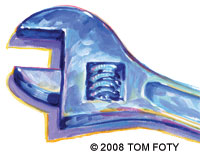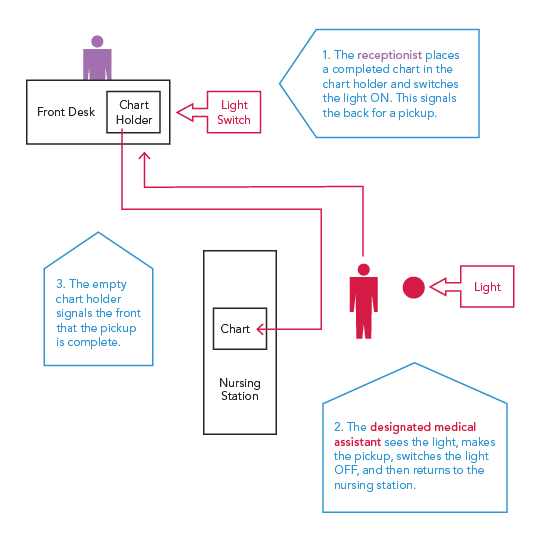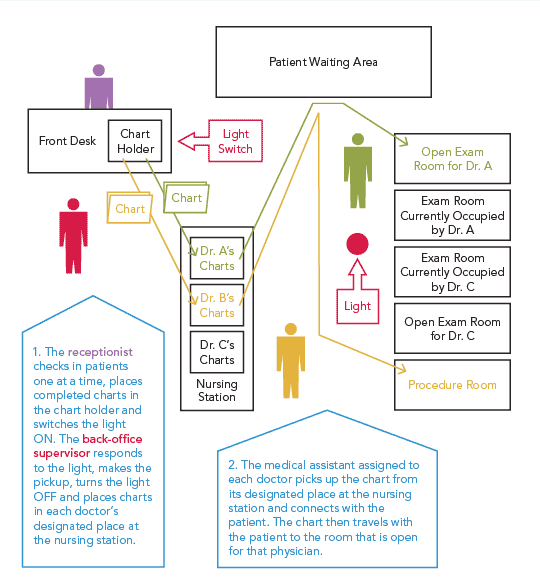
Developed by Toyota but applicable to medical practice, these rules can transform the way you work.
Fam Pract Manag. 2008;15(6):29-33
Author disclosure: nothing to disclose.

It has often been said that the definition of insanity is doing the same thing over and over and expecting different results. Most medical practices have been guilty of this at one time or another. Despite hard work and good intentions, they find themselves repeatedly trying to fix problems they thought they had already solved.
What's often missing in medical practices is a basic understanding of effective workflow design. Toyota is hailed in the business world for developing an incredibly successful production system, which is guided by four rules that are easily adaptable to any process, including those in medical practices.1 Following these simple rules can increase your odds of designing your processes right the first time.
Rule 1 addresses how people work: All activities must be highly specified as to content, sequence, timing and expected outcome.
Rule 2 addresses how people communicate: All communications must be highly specified and direct, with clear yes-no signals back and forth.
Rule 3 addresses how pathways are constructed: The pathway for every service or product must be pre-defined, highly specified, simple and direct – with no loops or forks.
Rule 4 addresses how improvements are made: All improvements must be made using data-driven scientific methods, as close to the work as possible, by the people who do the actual work and under the guidance of a teacher or coach.
The four rules in action
To illustrate the four rules in action, let's walk through the process a medical assistant follows to “room” a patient. In the ideal practice, which should always be the goal, the patient would be taken into the correct exam room immediately upon arrival, where the medical assistant would learn and document exactly what the patient needed at that visit, measure and document the patient's vital signs correctly, prep the patient for exactly the service needed, and then turn the patient over to the right physician, who is ready to see the patient just at that moment. The medical assistant would do all of this in a way that was emotionally, physically and professionally safe and appropriate.
Rule 1: Specify each step. The first rule states that all of the actions involved in rooming patients must be highly specific as to their content, sequence, timing and expected outcome. This sounds fairly simple, and most practices believe that their processes are highly specified, for example, go get the patient, confirm the reason for the visit, collect any needed specimens, obtain the vital signs, have the patient change and hand the patient off to the doctor. But these specifications leave too much room for variation, and with variation comes error.
Consider just one step in this process – obtaining the vital signs. Suppose one medical assistant always has the patient sit in a chair with both feet planted on the floor while confirming the reason for the visit. She then measures the temperature first, the pulse second, the respiratory rate third and the blood pressure last. She takes her time to do things carefully; she counts respirations for a full minute, and she lets the mercury in the sphygmomanometer drop very slowly as she listens. The other medical assistant usually asks the patient about the reason for the visit as they walk to the exam room. He then has the patient sit on the end of the exam table – feet dangling in the air – while he pops in the thermometer and simultaneously measures the blood pressure. Then he checks the pulse and respirations for fifteen seconds each, multiplies by four, writes all the numbers down and is out the door and on to the next patient.
The physicians know they can rely on the first medical assistant to collect good information from patients, and they can trust that her blood pressure measurements are accurate. But she drives the fast doctors crazy because she is too slow. On the other hand, the speedy doctors love the second medical assistant because he keeps up with them … though they always recheck his blood pressure measurements on patients with hypertension. The practice has tried repeatedly to address both speed of patient flow and accuracy of vital signs – to no avail – and there is a palpable undercurrent of blaming each medical assistant for these flaws.
The flaws are really due to a failure to follow rule 1. Each medical assistant should measure blood pressure in exactly the same way every time, using the same sequence of steps, with each step spelled out in great detail. A protocol should be readily available, and everyone who might measure pressures should be trained in this protocol. The protocol should also note the amount of time required to complete the measurement, so the timing can be accounted for in the entire rooming process. The protocol might be a checklist like the one shown on page 31, which standardizes blood pressure measurement. Rule 1 is really about eliminating ambiguity and variation in a process, which in turn eliminates error and inefficiency.
Rule 2: Communicate directly. The second rule states that all communications must be highly specified and direct, with clear yes-no signals back and forth. One of the ways this rule affects the rooming process is in how medical assistants are told that the next patient has arrived. In our practice, the front desk and the nursing station are in separate hallways, so the medical assistants have no view of the waiting area or the front desk. Before applying rule 2 to this problem, we had no quick, reliable way for the front desk to signal the medical assistants that a patient had arrived and was checked in. After thinking about the rule, the staff asked to have a small red light installed on the wall facing the nursing station. The light switch is located at the front desk, and the receptionist simply turns it on when a patient is ready to be roomed. The communication is simple and direct. (See the communication process outlined on page 32.)
Rule 3: Follow simple and direct pathways. This rule dictates that the pathways staff members follow to carry out a task must be predefined, highly specified, simple and direct – with no loops or forks. In a busy practice, where patients come in for a wide variety of needs, it can be difficult to imagine pathways with no loops (doubling back) or forks (more than one possible route). But if you break down the entire patient-care process into multiple, well-defined, linked steps, the concepts behind rule 3 become more apparent. The pathway for each individual component of care must be direct, although the complexities of caring for an individual patient may involve many conjoined pathways.
For example, imagine two patients have just been checked in and need to be roomed, one in an exam room and the other in a procedure room. The map on page 33 shows that in our practice there is only one possible pathway for each patient's chart. After the receptionist has placed the completed chart in the designated vertical file and switched the rooming light on, the back-office supervisor picks up the chart, switches the light off and places the chart in the appropriate doctor's designated space on the nursing station counter. Next, the medical assistant assigned to that doctor picks up the chart from its designated place at the nursing station, connects with the patient and travels with the patient to the room that is open for that physician. The chart travels from point A to point B without any loops or forks. The pathway is predesignated and obvious to everyone involved.
Rule 4: Let staff members and data drive process improvements. The final rule requires that all improvements to a process be made using data-driven scientific methods, as close to the work as possible, by the people who do the actual work, with appropriate coaching. Traditional management from the “top down” is doomed to fail, since managers rarely understand a process at the level of detail needed for effective redesign. The people who live with the process in their day-to-day work are the ones who identify the problems and design viable solutions they can live with. Someone experienced in quality improvement or workflow design can provide guidance.
All improvement efforts should be treated as mini-experiments with measurement before and after to understand the impact of any change. This does not have to involve complicated statistical analysis. Measurement can be as simple as using a tally sheet to track the number of times patients cannot be scheduled with their own providers, or how many times the back-office staff runs out of a particular item in a week.
But beware. Even after you have collected good data about your problem, don't jump into making changes in a process before truly understanding it. Discerning where and how a process is flawed is not intuitive. Remember, the scientific method includes a hypothesis. If you consider the hypotheses that underlie each rule of work design, you will find clues to guide your process improvement. For example, several hypotheses behind rule 1 are as follows: “Those involved are capable of doing the activity as specified,” “Work conditions allow them to do the activity as specified” and “If the activity is done as specified, the outcome is exactly as expected.” After experimenting, you may find that your staff is perfectly capable and the process works when it is completed as specified, but your working conditions don't always allow your staff to complete the process as specified.
SPECIFYING EACH STEP
A protocol such as the one shown below can help a medical practice follow rule 1, which requires that all activities, such as measuring blood pressure, be highly specific.
Blood pressure measurement protocol
Wait until the patient has been sitting in a chair with back and arms supported and with feet resting on the floor for five minutes.
Place the cuff on the upper arm so the middle of the cuff is at the level of the right atrium (the mid-point of the sternum), the edge of the cuff is within the white lines marking the correct size, and the arrow marking the artery is centered over the antecubital fossa.
Instruct the patient not to talk.
Inflate the cuff to a pressure higher than where the first beat is heard (usually 180 mmHg to 220 mmHg).
Allow the pressure to drop 2 mmHg per second.
Record the number where you consistently hear the first beat as the systolic pressure.
Record the number where you consistently lose the beats as the diastolic pressure.
Time required: 6 minutes.
COMMUNICATING DIRECTLY
To eliminate communication gray zones within a process, practices should define who will provide what message in what form to whom. Tasks should never be left to the next available person. Instead, assign someone specific to each end of the communication pathway and make sure you have a clear “message sent/message received” signal that is visible to everyone.
In the rooming process shown below, a simple red light allows the front desk to communicate to the nursing staff that a patient is ready to be roomed. The flowchart on page 33 shows the rest of the process.

To accomplish rule 4, your practice's culture may need to shift away from one that blames individuals for errors toward an environment where everyone is accustomed to asking, “Why did this problem occur?” and then focuses on finding a solution.2
How to know when you've arrived
You'll know that you have successfully applied the four rules of work design when every staff member and physician can answer these questions consistently and without hesitation:
How do you do this task?
How do you know that you are doing it correctly?
How do you know that the outcome is exactly what is wanted and free of error?
What do you do if you have a problem? Physicians and other health care providers are savvy problem solvers. With these basic design rules, you can begin fixing the flaws in your work design, which will get you and your staff to the right process – which will yield the right result.
FOLLOWING SIMPLE AND DIRECT PATHWAYS
For each part of a process there should be only one possible pathway, and it should be direct. In the rooming process shown below, the patient chart travels from the front desk to the exam room with no loops or forks.
